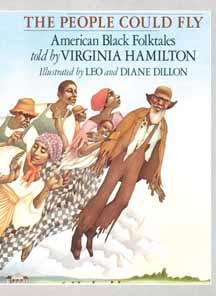| People could fly : American Black folktales Author: Hamilton, Virginia | ||
| Price: $6.50 | ||
Summary:
Retold Afro-American folktales of animals, fantasy, the supernatural, and desire for freedom, born of the sorrow of the slaves, but passed on in hope.
| Illustrator: | Dillon, Leo |
| Dillon, Diane |
| Accelerated Reader Information: Interest Level: MG Reading Level: 4.30 Points: 4.0 Quiz: 44962 | Reading Counts Information: Interest Level: 3-5 Reading Level: 4.30 Points: 6.0 Quiz: 08965 | |
Awards:
Coretta Scott King Author Award, 1986
Coretta Scott King Illustrator Honor, 1986
Common Core Standards
Grade 3 → Reading → RL Literature → 3.RL Key Ideas & Details
Grade 3 → Reading → RL Literature → 3.RL Craft & Structure
Grade 3 → Reading → RL Literature → 3.RL Integration & Knowledge of Ideas
Grade 3 → Reading → RL Literature → Texts Illustrating the Complexity, Quality, & Rang
Grade 4 → Reading → RL Literature → 4.RL Key Ideas & Details
Grade 4 → Reading → RL Literature → 4.RL Range of Reading & Level of Text Complexity
Grade 4 → Reading → RL Literature → 4.RL Craft & Structure
Grade 4 → Reading → RL Literature → 4.RL Integration & Knowledge of Ideas
Grade 4 → Reading → RL Literature → Texts Illustrating the Complexity, Quality, & Rang
Grade 3 → Reading → RF Foundational Skills → 3.RF Fluency
Reviews:
Kirkus Reviews
School Library Journal (+)
Booklist (+)
The Bulletin of the Center for Children's Books
The Hornbook (+)
Full Text Reviews:
School Library Journal - 11/01/1985 Gr 4-7 The well-known author here retells 24 black American folk tales in sure storytelling voice. In four groupings she presents seven animal tales (including a tar-baby variant); six fanciful ones (including ``Wiley, His Mama, and the Hairy Man'' and a tale of which Harper's Gunniwulf Dutton, 1967 is a variant); five supernatural tales (including variants of the Tailypo, John and the Deviland a wild cautionary tale, ``Little Eight John''); and finally, six slave tales of freedom, closing with the moving title story. Depending on the sources, some of the tales use a modified dialect for flavor; one told with quite a few words of Gullah dialect has a glossary. All are beautifully readable. The book has a bibliography, and comments follow each tale, including one personal note of a family account involving one of her grandfathers. Two other collections of black folk tales, Courlander's Terrapin's Pot of Sense (Holt, 1957; o.p.) and Faulkner's The Days When the Animals Talked (Follett, 1977; o.p.) are both out of print. With the added attraction of 40 bordered full- and half-page illustrations by the Dillons wonderfully expressive paintings reproduced in black and white this collection should be snapped up. Ruth M. McConnell, San Antonio Public Library - Copyright 1985 Publishers Weekly, Library Journal and/or School Library Journal used with permission.
Booklist - 07/01/1985 *Starred Review* In her own voice, which is true to the original stories in all their variety, Hamilton retells 24 representative black folktales with immediacy and drama. The stories are organized into four sections: tales of animals; the supernatural; the real, extravagant, and fanciful; and freedom tales. There are famous stories, such as “Tar Baby” (of which more than 300 versions are known worldwide) and also the less well known (including several tales brought to the U.S. by immigrants from the Cape Verde Islands off the coast of West Africa). Hamilton’s introduction emphasizes the creativity of the slaves, whose stories combined their African heritage with the sorrow of their oppression, as they secretly and symbolically told one another their hopes and fears. At the end of each story, a brief note discusses topics such as origin, variants, motifs, and symbolic meaning. A long bibliography lists adult collections and commentary. Many of the stories demand to be told or read aloud. They start directly and develop with exaggeration, comedy, horror, and wit: the Ugly Hairy Man was “coarse-hairy all over. His eyes burned red as fire. He had great big teeth, with spit all in his mouth and running down his chin.” They may end with a laugh or a shiver. The true slave narrative about rowing runaways across the Ohio River has a stark poetry: “We were so scared and it was so dark and we knew we could get caught and never get gone”; Hamilton relates this account to her grandfather’s story of escape. The beautiful title story, both anguished and hopeful, is about those who flew away from brutality to freedom, and those who had to stay and who told the story. From The House of Dies Drear to The Magical Adventures of Pretty Perl, Hamilton has made folklore an integral part of her fiction. Now she tells the stories for themselves with a simple power that will make this a classic collection for all ages. The book is illustrated with 40 vigorous and beautiful paintings by Diane and Leo Dillon. - Copyright 1985 Booklist.



